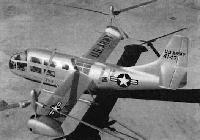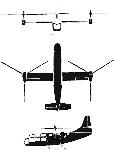Фотографии
-
This Ilyushin Il-12 arrived at London Airport on 23rd February bringing Mr. Gromyko to London. Modifications to the normal Il-12 outline include a redesigned fin and rudder.
Самолёты на фотографии: Ильюшин Ил-14 - Россия - 1950
-
Регистрационный номер: D3117 One of the earliest known modifications of an R.A.F. aircraft for casualty evacuation duties - a de Havilland DH.9 of "Z Force", operating in Somaliland in 1919. It carried one stretcher and an attendant in addition to the pilot.
Самолёты на фотографии: De Havilland D.H.9 - Великобритания - 1917
-
The Handley Page H.P.56 was designed to P.13/36, with two Vultures. Two prototypes were ordered, as were two Avro Manchesters to the same specification. The two prototype H.P.56s were eventually built with four Merlins and became the prototype H.P.57 Halifaxes. This is the first general arrangement drawing to be published of the H.P.56.
Самолёты на фотографии: Handley Page Halifax / H.P.57 - Великобритания - 1939
-
Регистрационный номер: XB-TAN Photographed at Chester in 1953, XB-TAN was a Dove ordered for Mexico. It was not delivered and has now become XJ321, the third Sea Devon for the Royal Navy.
Самолёты на фотографии: De Havilland Dove / D.H.104 - Великобритания - 1945
-
BELL XV-3. A remarkable convertiplane with tilting rotors, the Bell XV-3 is expected to fly for the first time within a month or two. Rotors at the wingtips can be tilted through 90 degrees and in level flight act as propellers. Rotation of the propellers is effected by electric motors, the main power plant being in the fuselage. The XV-3 is under development for the V.S. Army.
Salient features: Fuselage of the XV-3 has a pleasantly rounded nose, multi-panelled windows and marked upsweep on the rear underside. The engine in the fuselage centre-section has intakes on top of which are panels let into the skin. The constant-chord wing is of high aspect ratio, and terminates at the tips in large bulges upon which are mounted very tall rotor heads, waisted towards the bulges and carrying three-blade rotors. The tall, square-cut fin with its large dorsal fillet and tailplane set well up, is similar to that mounted on the Bell Airacomet. The undercarriage of the XV-3 consists of tubular skids on twin tube mountings under the fuselage.Самолёты на фотографии: Bell XV-3 - США - 1955
-
BELL XV-3. Data: Manufacturer: Bell Aircraft Corporation, P.O. Box 1, Buffalo 5, New York. Power: one Pratt and Whitney R-2800 radial of 2,000 h.p. Accommodation: four-seat. Dimensions: span 30 ft.; length 30 ft.; height 13 ft. Weights: no data available. Performance: maximum speed over 175 m.p.h.; no other data available.
Самолёты на фотографии: Bell XV-3 - США - 1955
-
NU-200 Sikumbang. First flown in August 1954, the NU-200 Sikumbang is the second powered aircraft to be built in the Republic of Indonesia. A single-seater, it is intended as a prototype general purpose close-support aircraft probably to be armed with machine guns and bombs or rockets. No announcement has yet been made on production of the type.
Salient features: A low-wing monoplane, the Sikumbang has domed braced canopy, long nose and blunt fuselage tail. The nose has a distinct hump on it and the propeller boss is covered by a pointed spinner. Wings are equi-tapered and square-cut with prominent trailing-edge root fillets. The fin is equi-tapered with slightly rounded top and small dorsal fillet. The fixed undercarriage has cantilever legs which are forward raked. A small fixed tailwheel is also fitted.Самолёты на фотографии: LIPNUR NU-200 Sikumbang / NU-225 - Индонезия - 1954
-
NU-200 Sikumbang. Data: Manufacturer: Indonesian Air Force, Technical Staff, Aircraft Maintenance Depot, Experimental Section, Bandung, Java. Power: one de Havilland Gipsy Six of 200 h.p. Accommodation: single-seat. Dimensions: span 34 ft. 9in.; length 26 ft. 9 in.; height 11 ft. All-up weight: 2,400 lb. Performance: maximum speed at sea level 160 m.p.h.; cruising 140 m.p.h.; landing speed 55 m.p.h.; initial rate of climb over 1,000 ft. per min.; service ceiling 16,500 ft.; range 600 miles.
Самолёты на фотографии: LIPNUR NU-200 Sikumbang / NU-225 - Индонезия - 1954
-
BLAIRVACQ-PIEL EMERAUDE. Yet another interesting French ultra-light aircraft in the same class as the Jodel, the Emeraude is available in complete, kit, or on!y plan form and already some 15 are under construction by various groups and individuals in France. Very high performance is claimed for the aircraft and almost viceless flying characteristics. Despite the unusual wing form, construction is understood to be relatively simple.
Salient features: The Emeraude's squat fuselage is slab-sided and the nose is broad and blunt. Slope down from the top of the two-seat (side-by-side) cabin is gentle and the fuselage bottom is flat. There are cabin doors on either side. The wing planform is reminiscent of the Tempest, with curved leading and trailing edges and blunt tips. Dihedral is from the roots. Tailplane, set well up on the fuselage, has greatest taper on the trailing edge and cut-outs for rudder movement. The fin has a flat top and is faired into the fuselage top-line, while the rudder trailing edge has sharp taper. The tailwheel undercarriage has cantilever main legs.Самолёты на фотографии: Piel Emeraude / Diamant / Beryl - Франция - 1952
-
BLAIRVACQ-PIEL EMERAUDE. Data: Manufacturer: Blairvacq-Piel Aviation, 284 Avenue Jean Jaurts, Drancy, Seine. Power: one 65-h .p. Continental or any suitable engine of 90 h.p. Accommodation: two-seat. Dimensions: Span 29 ft. 7 in.; length 21 ft.; height 7 ft. 4 in. Weights: empty 610 lb.; useful load 485 lb.; all-up weight 1,095 lb. Performance: maximum speed at sea level 118 m.p.h.; cruising speed 105 m.p.h. ; rate of climb 882 ft. /min.; stalling speed 37 m.p.h.; ceiling 14,800 ft.; range 830 miles.
Самолёты на фотографии: Piel Emeraude / Diamant / Beryl - Франция - 1952
-
LEARSTAR. Latest conversion of the ubiquitous Lodestar, the Learstar is claimed to be the only production twin-engine transport aeroplane capable of cruising at over 300 m.p.h. at 10,000 ft., and of flying 3,800 miles non-stop. The Learstars are fully converted Lodestars with new engine nacelles, landing gear, modified wing and tailplane tips, new tail cone and nose, plus numerous detail alterations. 1955 production of the Learstar is scheduled at two machines per month.
Salient features: Fuselage of the Learstar is deep with long streamlined nose and blunt tail cone. The underside of the fuselage curves smoothly towards the rear, while the only kink in the top-line is towards the tail. The cabin has a deep windscreen with long windows leading back from it. Wings have straight taper on the leading edge and compound taper on the trailing edge. Tips are pointed. Deep engine nacelles, with circular cowlings head-on, are semi-underslung with prominent rear bulges for the undercarriage. The tailplane, with leading-edge taper only, is set on top of the fuselage and carries slightly inset oval fins. Tailwheel is retractable and the mainwheels retract into the nacelles.Самолёты на фотографии: PacAero Learstar - США - 1953
-
LEARSTAR. Data: Manufacturer: Lear Incorporated, Santa Monica Airport, California. Power: two 1,425-h.p. Wright 1820-76 radials. Accommodation: two crew and twelve passengers. Dimensions: span 65 ft. 6 in.; length 51 ft. approx. Weights: maximum gross weight 22,500 lb. Performance: maximum cruise over 300 m.p.h.; ranges, 1,600 miles at 280 m.p.h. and maximum, 3,800 miles at 216 m.p.h.; rate of climb at sea level 2,720 ft./min.; service ceiling 31,600 ft.; stalling speed, flaps down, 82.7 m.p.h.
Самолёты на фотографии: PacAero Learstar - США - 1953











